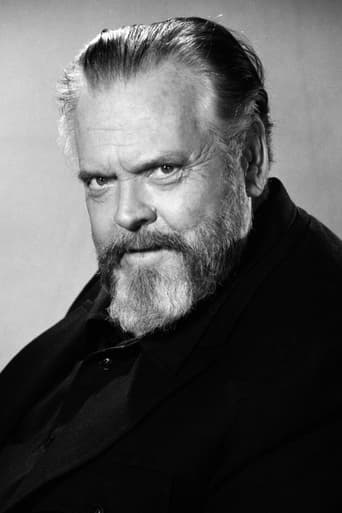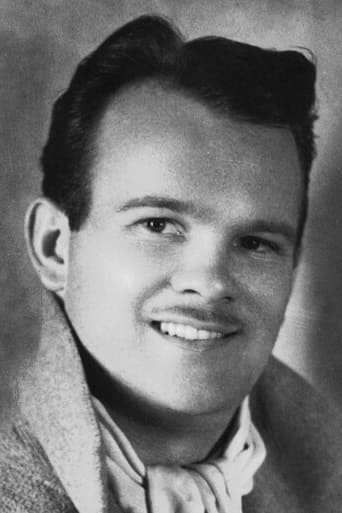Afouotos
Although it has its amusing moments, in eneral the plot does not convince.
Doomtomylo
a film so unique, intoxicating and bizarre that it not only demands another viewing, but is also forgivable as a satirical comedy where the jokes eventually take the back seat.
Catangro
After playing with our expectations, this turns out to be a very different sort of film.
Jakoba
True to its essence, the characters remain on the same line and manage to entertain the viewer, each highlighting their own distinctive qualities or touches.
hotcrossplums
This historical look back on Bugs Bunny and the early Warners animators is a mix between an interesting look back and a mind-numbingly bore. After a rough start, the documentary (with very old school cartoons mixed in) becomes really interesting as it contrasts the work of animation in the 1930s and "today" (the 1970s, when this was made). There is plenty of historic footage and old pictures. I think I might have been more fascinated if I were a hard-core Looney Tunes fan. Some of the cartoons mixed in were kinda...boring. All in all, it is very worth-while as a historic look back at the Warners Brothers cartoons and the journey that cartooning has taken between then and now.
Lee Eisenberg
When I was five, I first saw the documentary "Bugs Bunny Superstar" and my parents made me a tape of it; unfortunately, we accidentally taped over the end. Now that I've seen the whole thing again - and that I'm old enough to understand what it shows - I can accurately comment on it.It starts with a disembodied voice (actually Orson Welles narrating) showing photographs of the places representing the greatest minds: the Great Wall of China, the Taj Mahal, the Pyramids, the Parthenon, the Coliseum, the Eiffel Tower, the White House (well, not currently), Termite Terrace...wait a minute, Termite Terrace? Yes, Termite Terrace. For the uninformed, it's the back-lot on the Warner Bros. studios where they created the Looney Tunes/Merrie Melodies cartoons. So begins a cinematic trip down Memory Lane.The movie consists of an interview with animator Bob Clampett explaining how they created Bugs, Daffy, Porky, etc. When I was really young, even though I saw the caricatures of Humphrey Bogart, Peter Lorre and Edward G. Robinson - plus the scenes from "The Jazz Singer" and "It Happened One Night" - I couldn't interpret anything from them, but of course now I can. It was especially neat to hear about the typical days in Termite Terrace; it all sounded really fun! But of course, the best parts are the nine classic cartoons included in the movie to affirm what Clampett says. All released before 1948, they give one a true sense of old-time cinema (especially with Bugs Bunny at the Oscars). As it is, this documentary's 1975 release brings to mind the '50s nostalgia that had swept the country, as displayed by "Happy Days". While the stuff portrayed here is pre-'50s, it still makes one nostalgic for the old times. You're sure to have a real hare-raising time! There's also an interview with Friz Freleng, some footage of Mel Blanc, while Elmer, Sylvester, Tweety, and Foghorn also appear in the cartoons.One more thing. When MGM released "Bugs Bunny Superstar" on video in 1988, they also released the video collections "BUGS!" (whose cover showed Bugs holding an Oscar), "DAFFY!" (showing Daffy wearing sunglasses), "PORKY!" (showing Porky driving a fancy car), and "ELMER!" (showing Elmer sitting in a director's chair). In keeping with the documentary, they all contained cartoons released before or during 1948 (e.g., "Bugs Bunny Gets the Boid", "The Great Piggy Bank Robbery", "Baby Bottleneck" and "Good Night, Elmer"). I wonder why MGM released them onto video.
gridoon
This compilation features priceless archival footage from the WB animation artists' working and living conditions, and nine entertaining, timeless cartoon shorts. Although it eventually wears you out a little (I think those cartoons look better if taken in smaller doses), it is a much better choice for family viewing than many, many other films that claim to serve the same purpose. Long live Bugs! (***)
Alice Liddel
This superb compilation, appropriately narrated by another American cultural giant, Orson Welles, features the best of the 1940s Looney Tunes output, not just Bugs, but Sylvester, Tweetie, Daffy, Porky and Foghorn: 'What's Cookin' Doc', 'A Wild Hare', 'A Corny Concerto', 'Rhapsody Rabbit', 'I Saw A Putty Tat', 'Walky Talky Hawky', 'My Favorite Duck', 'Hair Raising Hare' and ''Old Grey Hare' (see my individual reviews).As a piece of cultural history, this semi-documentary is inadequate - there is no attempt to explain the subversiveness of these irreverent, flippant, violent, beautiful cartoons in the context of Disney-dominating ick-animation and gloomy, propaganda-laden World War Two - to which many of these cartoons tacitly refer, revealing complicated truths other 'real' films couldn't dare, such as the barbaric effect fighting barbarians can have on 'our' side; there is no analysis of the glorious pretention-pricking of both Hollywood and high culture, or Bugs' androgynous proteanism, or how the cartoons retained a level of fresh invention while seemingly locked in repetitive formulae; of the powerful psychoanalytic premisses of each short, in which a wild, elusive, lawless animal stands in for our stifled desires, especially as World War Two gives on to the post-war world of Joe McCarthy and chums.Rather, the in-between nostalgic bits celebrate harmless anecdote and japery, putting animation on its proper, neutered level. The cartoons themselves triumphantly bely such a project.





